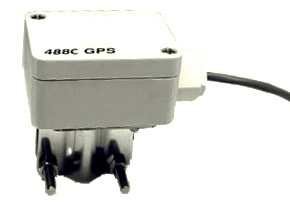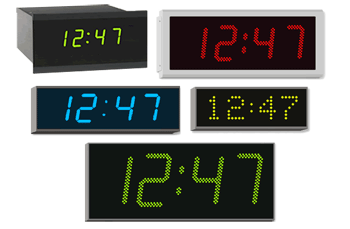TimeLord-Net - Reference-locked NTP Master Clock System

The industry-standard TimeLord-Net Master Time Source has been re-designed and re-engineered to take advantage of the latest advances in technology. It is now modular in design and provides a complete precision time synchronisation solution for computer networks, CCTV security, CCC/C3, digital clock systems, analogue clocks (with hands), industrial process control, voice recording and many other applications requiring accurate time synchronisation of equipment. It supersedes the previous TimeLord-Lite range providing extra functionality at a lower price.
The TimeLord-Net may be used in stand-alone mode, deriving its timekeeping from its accurate, high stability, internal crystal oscillator or, for ultimate precision, synchronised via optional receivers to GPS satellites or DCF and MSF terrestrial radio time code transmitters.
The TimeLord can be synchronised to any of the following Time References Inputs as standard with the appropriate receiver head:

- GPS Satellite Time Reference
- GLONASS Satellite Time Reference – also in GLONASS-with-GPS assistance mode
- MSF Atomic Reference – BST (British Standard Time) – UK (now in Cumbria – was Rugby)
- DCF Atomic Reference – CET (Central European Time) – Germany (Mainflingen nr Frankfurt)
- NTP Network Time Protocol from remote NTP Time Server located on the same TCP/IP Network including the internet
- SNTP Simple Network Time Protocol from remote NTP Time Server located on the same TCP/IP Network including the internet
The following Optional Input Interface Modules are also available:
- SYNC2-IN Additional Receiver-Head Synchronisation Interface allows connection of two receiver heads for dual redundant functionality
- AF-IN Audio-Input Interface allow synchronisation from IRIG-B or EBU-LTC Timecode
- OPT-IN ST Fibre-Optic Input Interface to allow synchronisation from optically-connected time code signals
The TimeLord provides the following Data Output Interfaces as standard:
- V-Code Configurable single V-Code Output for either 482 Multi-Zone Time/Date code for Digital Clocks, Active MSF, Active DCF or 24V bi-phase Impulses for Analogue Clocks (with hands)
- Serial RS232 and RS422/RS485 Serial Outputs which can transmit one of more than 85 different serial ASCII time-and-date telegrams in user-selected formats and intervals
- 1PPS High-Accuracy 1PPS Pulse-per-second Output at RS-232 levels
- Ethernet 10/100Base-T Ethernet RJ45 NTP network interface.
The following Optional Output Interface Modules are also available:
- AF-OUT Dual Audio Time Code outputs for EBU LTC TimeCode or modulated IRIG-B
- SER-OUT Dual RS-232/RS-485 Serial Interface (in addition to the in-built serial port)
- OPT-OUT Dual ST Fibre-optic output either demodulated IRIG-B, EBU LTC Timecode or Serial ASCII data
- RLY-OUT Dual Programmable Relays (mains-rated)
- PPS-OUT High Voltage (110V DC) PPS Pulse-per-second PPS Periodic Outputs
- DEM-OUT 4x Mirrored logic level outputs for IRIG-B, EBU-LTC, MSF or DCF Timecodes, PPS or other Periodic signals
POWER OPTIONS
- Single Mains Input is standard
- DUAL-AC Dual redundant universal mains power supply (Optional)
- 24V-IN Isolated 24VDC Input (Optional)

The NEW Timelord-Net NTP Master Time Source is housed in a 1U high 19″ rack mount case and provides time data outputs for computer networks, digital displays, analogue clocks (with hands) and virtually anything that requires an accurate time-stamp. A 2-U version is available to accommodate additional optional input and output modules. The high-visibility 6-digit red LED display can show time or date, has adjustable brightness and can be read at distances of up to 7m. The TimeLord-Net is delivered pre-programmed with a 256-year calendar that includes daylight savings changes for all the 90+ Time Zones worldwide – plus custom time zones can be manually programmed if required. Programming is simply accomplished via an intuitive setup menu, using the 4 buttons on the front panel.
TIMEBASE
The internal, high stability, TCXO Temperature-Compensated Quartz Crystal Oscillator typically provides an accuracy of ±0.1 seconds per day @ 0-45°C (approximately ±2 seconds per month). The free-running accuracy of the oscillator is automatically trimmed over a long time period when the TimeLord is referenced to an external atomic reference to further improve the free-run accuracy. With the optional TCXO-HQ installed, the free-running accuracy is further improved to typically ±0.01 seconds per day @ 0-45°C (approximately ±0.2 seconds per month = ±2½ seconds per year approx) When synchronised with the GPS satellite network via the optional V-488C.00 GPS receiver system, the RS232 level 1PPS ‘on-time’ pulse is maintained typically within 10µS of UTC. When synchronised with DCF or MSF Radio Time Code Transmissions, via an optional V-484 series time code receiver, the Timelord-Net output signals are maintained within 30mS of UTC. When synchronised to an NTP Time Source (setup as an NTP Client), the Timelord-Net Time Source output signals are maintained within 1-10mS of the NTP Source depending on network delay and jitter.
The TimeLord-Net Master Time Source has a 250-year internal calendar with 4-digit year setting, including for each time zone, offset from UTC and daylight savings change information. A simple “set-once” Time Zone Setup facility for any location in the world is provided, automatically calculating the appropriate time offsets from UTC and future seasonal time changes.
OPTIONAL INPUT INTERFACES
SYNC2-IN allows connection of a 2nd Receiver Head to provide dual redundant functionality. The 2nd Receiver Head may use the same or a different atomic reference and the TimeLord will only change to the backup off-air reference in if the main reference fails and if the backup which is validated during the synchronization process. AF-IN Audio-Input Interface allows synchronisation from a modulated audio time reference, including IRIG-B – commonly-used in industrial, marine and aviation time-keeping applications – and EBU-LTC longitudinal Timecode commonly-used for Broadcast and CCTV/Security. OPT-IN ST Fibre-Optic Input Interfaces allows synchronisation from optically-connected time code signals including demodulated IRIG, EBU and Serial Time data.
STANDARD REFERENCE INPUT INTERFACE CONFIGURATION
OFF-AIR RECEIVER INPUT 2-part terminal block provides twisted-pair interface to Receiver Head and power for GPS (screw terminals – 4-way) and separate RJ45 for NTP-locking
- GPS Satellite Time Reference – uses V-488C.00 GPS Antenna / Interface with twisted pair connection (coax/triax not needed)
- MSF Atomic Reference – BST (British Standard Time) – UK (now in Cumbria – was Rugby) – uses V-484.02 Receiver Head – with twisted pair connection
- DCF Atomic Reference – CET (Central European Time) – Germany (Mainflingen nr Frankfurt) – uses V-484.03 Receiver Head – with twisted pair connection
- NTP Network Time Protocol from remote NTP Time Server located on the same TCP/IP Network including the internet – uses RJ45 Ethernet Connection
- SNTP Simple Network Time Protocol from remote NTP Time Server located on the same TCP/IP Network including the internet – uses RJ45 Ethernet Connection
NTP OUTPUT An RJ45 connector provides an Ethernet connection for NTP output NTP NETWORK TIME PROTOCOLS SUPPORTED
- NTP Network Time Protocol (NTP) v2, v3 and v4 clients are supported in both unicast and broadcast modes of operation (RFC1305 & RFC1119)
- SNTP Simple Network Time Protocol (SNTP) v3 and v4 clients are supported in both unicast and broadcast modes of operation (RFC2030 & and RFC1769C)
- TIME TIME Protocol (RFC868) is supported in UDP and TCP Modes
- DAYTIME DAYTIME Protocol is supported in UDP and TCP Modes
- Every 5 seconds
- Every minute
- Every hour
- Once per day at a user programmable time
- On power failure
- While locked to an external time reference
- During an error state


Intelligent Impulse Output Bi-Phase impulses to drive Impulse Analogue Clocks (with hands) can be produced by the TimeLord-Net which automatically corrects for daylight saving changes and also catches up when the mains fails. At setup, all the clocks on the same impulse output are manually moved to show the same time and that time is entered into the TimeLord Master Clock. 3x Forward pulses are then sent from the TimeLord and the wiring to any clock that has advanced by two steps should be changed round to ensure that all the clocks “tick” and “tock” together. The TimeLord is then set to RUN and the clocks on that impulse output either speed forward to catch up, or wait until that time arrives – whichever is faster – before moving forward at normal speed (either 1 pulse per second, one every half minute or one every minute internally settable). If there is a problem with the mains or the clock loop somehow becomes overloaded, all the clocks are stopped together (as opposed to some running and others not as the power reserve dies) and the TimeLord remembers that time.
When the mains returns, the clocks all step forward at fast speed to catch up. It is worth providing a UPS for the TimeLord to keep the impulse clocks running case of prolonged mains failure; the TimeLord’s internal battery maintains timekeeping for around 1 year but outputs are disabled to conserve battery energy.
OPTIONAL OUTPUT INTERFACES
AF-OUT Dual Audio Time Code outputs for EBU LTC TimeCode or modulated IRIG-B
The optional AF-OUT output interface adds two flexible Audio outputs that can be independently configured to provide either 1kHz modulated IRIG-B timecode for the synchronisation of voice recorders, data- logging and distributed control equipment, or EBU Longitudinal TimeCode for use in Broadcast, Secirity, CCTV and other applications. IRIG is normally transmitted as a modulated 1kHz signal at a 100Hz bit-rate and contains day-of-year, hours, minutes and seconds information. EBU Timecode is a self-clocking audio signal at 2kbps with each frame of data comprising 80 bits. Each timecode frame contains time, user information plus count-up and count-down information as well as user-programmable information. The time data includes hours, minutes, seconds and video frames (25 per second) and the user bits allow date and other information embedded within the timecode frame. The date format carried in the TimeLord EBU User-Bits signal can be set to one of two commonly-used standards for Broadcasting. The audio outputs are presented on BNC connectors and the interface is 600 ohm transformer-balanced which can be used to feed both balanced and unbalanced devices.
SER-OUT Dual RS-232/RS-485 Serial Interface (in addition to the in-built serial port)
The optional SER-OUT provides two additional RS232 and RS422/RS485 interfaces each of which can be programmed to provide one of more than 85 different serial ASCII time and date telegram message formats to be selected by the user.
General purpose serial data formats are user configurable for:
- 7 or 8 data bits
- Odd, even or no parity
- 1200, 2400, 4800, 9600 or 19200 baud rate
- The message output repetition rate is programmable for once per second, per minute, per five minutes, per hour, per day or on request
- OPT-OUT Dual Optical Outputs
- The optional OPT-OUT provides Dual ST Fibre-Optic outputs configured for demodulated IRIG-B, EBU Timecode or Serial ASCII Data. The connectors are ST-type designed for 62.5/125µm (820nm) fibre.
RLY-OUT Dual Programmable Relays (mains-rated)
The optional RLY-OUT provides dual 230V mains AC relays for the periodic signalling of error conditions and control of third-party equipment
PPS-OUT PPS Pulse-per-second PPS Periodic Outputs
The optional PPS-OUT provides dual High-Voltage pulse-per-second periodic outputs rated at 110V DC
DEM-OUT Demodulated Outputs
The optional DEM-OUT provides Quad logic level outputs that can be programmed to mirror either IRIG-B, EBU-LTC, MSF or DCF Timecodes, PPS or other Periodic signals

Support
| Timing Accuracy: |
| ||||||||||||||||
|---|---|---|---|---|---|---|---|---|---|---|---|---|---|---|---|---|---|
| Reference Inputs: (Off-Air Receivers) |
| ||||||||||||||||
| Optional Reference Input Interfaces: |
| ||||||||||||||||
| Standard Outputs: |
| ||||||||||||||||
| Optional Output Interfaces: |
| ||||||||||||||||
| Front Panel: (Controls and Indicators) |
| ||||||||||||||||
| Accessories: |
| ||||||||||||||||
| Physical: |
|
No Updates
